FIAT 500 ABARTH 2015 2.G Owners Manual
Manufacturer: FIAT, Model Year: 2015, Model line: 500 ABARTH, Model: FIAT 500 ABARTH 2015 2.GPages: 426, PDF Size: 9.89 MB
Page 221 of 426
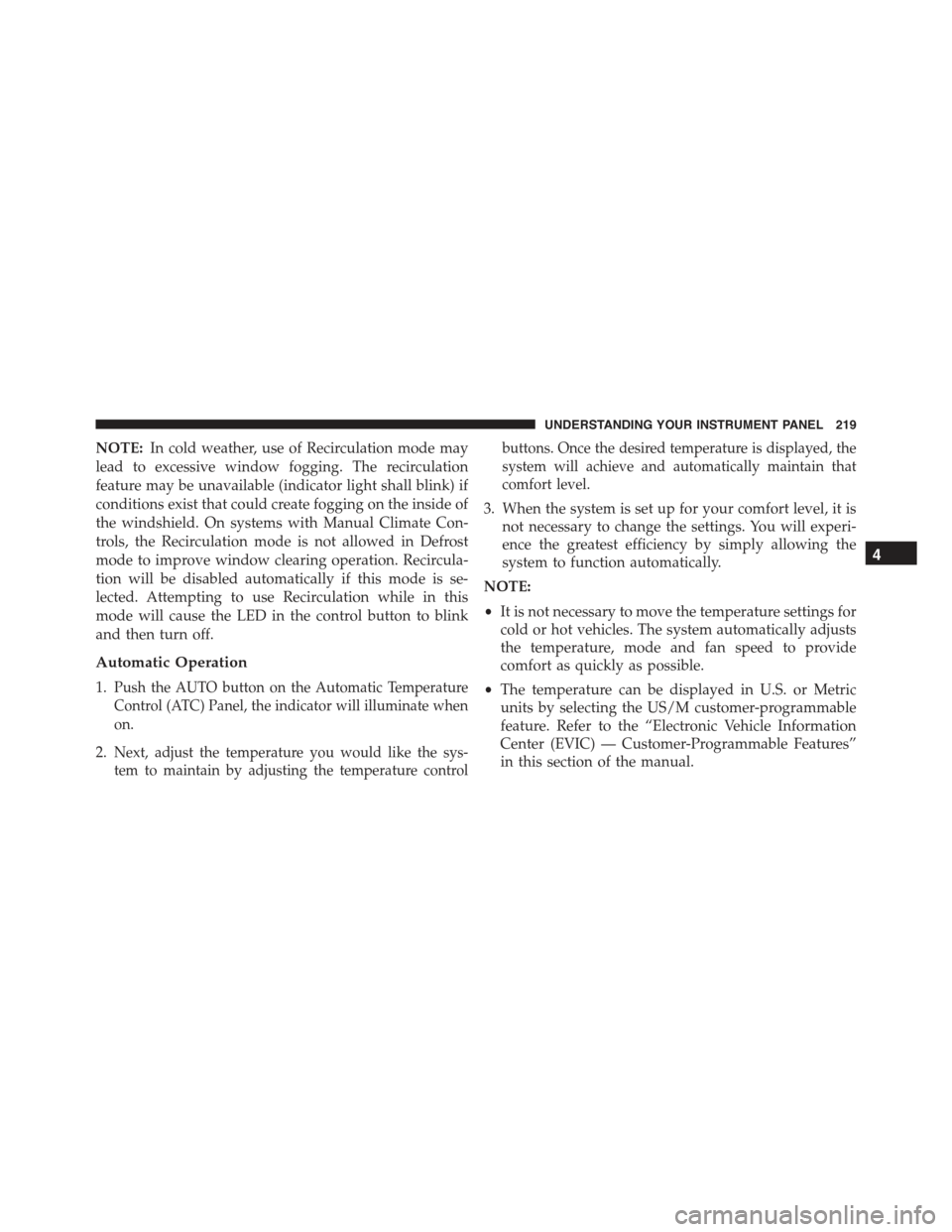
NOTE:In cold weather, use of Recirculation mode may
lead to excessive window fogging. The recirculation
feature may be unavailable (indicator light shall blink) if
conditions exist that could create fogging on the inside of
the windshield. On systems with Manual Climate Con-
trols, the Recirculation mode is not allowed in Defrost
mode to improve window clearing operation. Recircula-
tion will be disabled automatically if this mode is se-
lected. Attempting to use Recirculation while in this
mode will cause the LED in the control button to blink
and then turn off.
Automatic Operation
1.Push the AUTO button on the Automatic Temperature
Control (ATC) Panel, the indicator will illuminate when
on.
2.Next, adjust the temperature you would like the sys-
tem to maintain by adjusting the temperature control
buttons. Once the desired temperature is displayed, the
system will achieve and automatically maintain that
comfort level.
3. When the system is set up for your comfort level, it is
not necessary to change the settings. You will experi-
ence the greatest efficiency by simply allowing the
system to function automatically.
NOTE:
•It is not necessary to move the temperature settings for
cold or hot vehicles. The system automatically adjusts
the temperature, mode and fan speed to provide
comfort as quickly as possible.
•The temperature can be displayed in U.S. or Metric
units by selecting the US/M customer-programmable
feature. Refer to the “Electronic Vehicle Information
Center (EVIC) — Customer-Programmable Features”
in this section of the manual.
4
UNDERSTANDING YOUR INSTRUMENT PANEL 219
Page 222 of 426
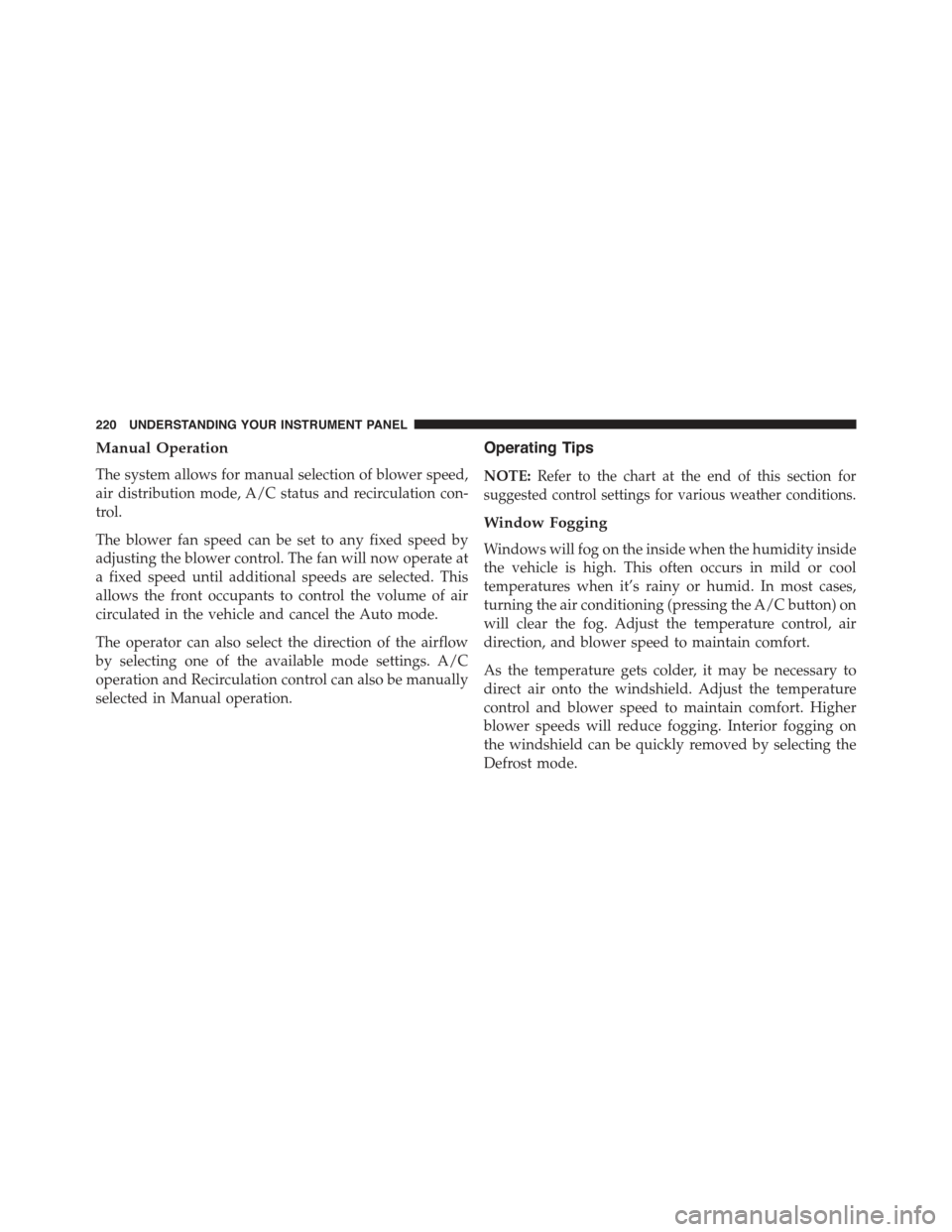
Manual Operation
The system allows for manual selection of blower speed,
air distribution mode, A/C status and recirculation con-
trol.
The blower fan speed can be set to any fixed speed by
adjusting the blower control. The fan will now operate at
a fixed speed until additional speeds are selected. This
allows the front occupants to control the volume of air
circulated in the vehicle and cancel the Auto mode.
The operator can also select the direction of the airflow
by selecting one of the available mode settings. A/C
operation and Recirculation control can also be manually
selected in Manual operation.
Operating Tips
NOTE:Refer to the chart at the end of this section for
suggested control settings for various weather conditions.
Window Fogging
Windows will fog on the inside when the humidity inside
the vehicle is high. This often occurs in mild or cool
temperatures when it’s rainy or humid. In most cases,
turning the air conditioning (pressing the A/C button) on
will clear the fog. Adjust the temperature control, air
direction, and blower speed to maintain comfort.
As the temperature gets colder, it may be necessary to
direct air onto the windshield. Adjust the temperature
control and blower speed to maintain comfort. Higher
blower speeds will reduce fogging. Interior fogging on
the windshield can be quickly removed by selecting the
Defrost mode.
220 UNDERSTANDING YOUR INSTRUMENT PANEL
Page 223 of 426
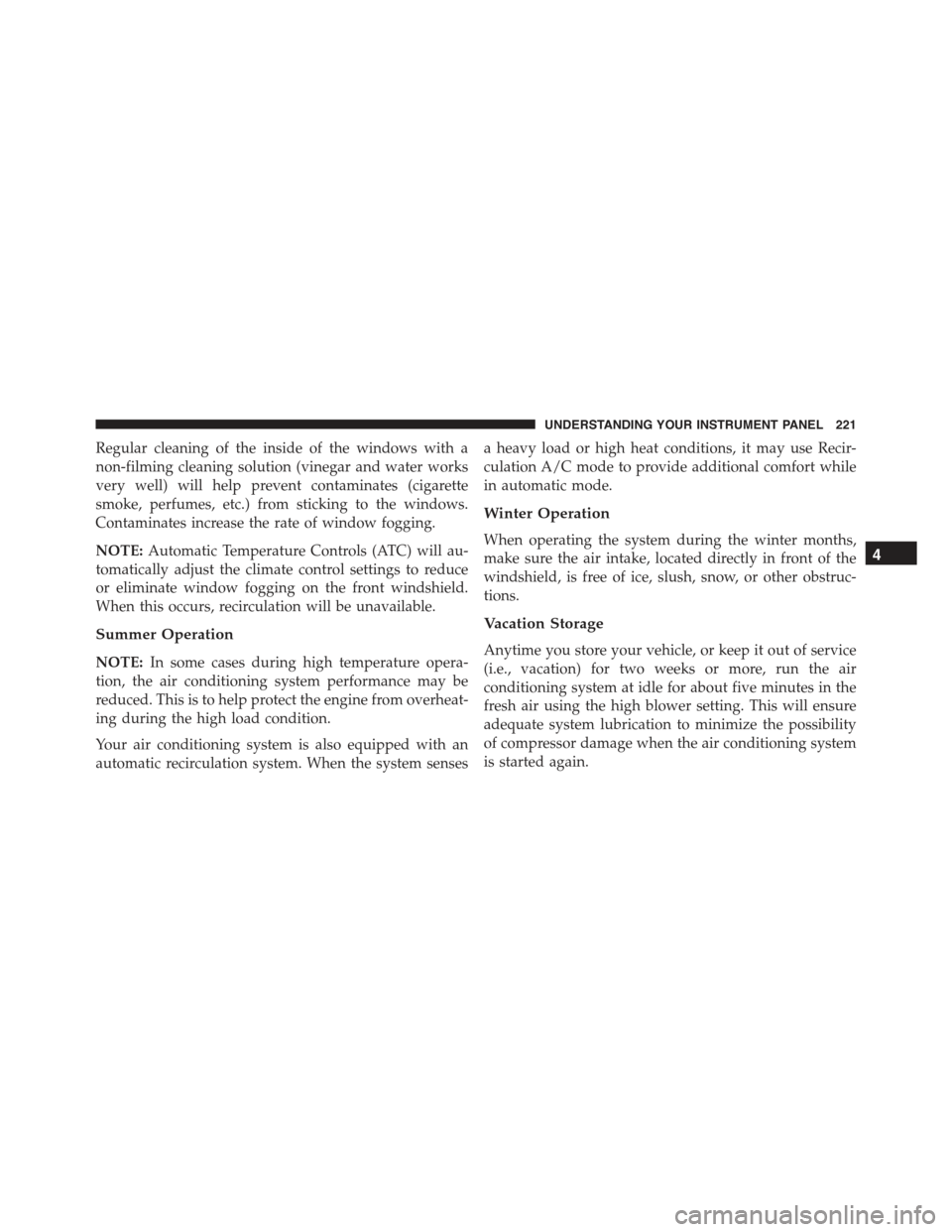
Regular cleaning of the inside of the windows with a
non-filming cleaning solution (vinegar and water works
very well) will help prevent contaminates (cigarette
smoke, perfumes, etc.) from sticking to the windows.
Contaminates increase the rate of window fogging.
NOTE:Automatic Temperature Controls (ATC) will au-
tomatically adjust the climate control settings to reduce
or eliminate window fogging on the front windshield.
When this occurs, recirculation will be unavailable.
Summer Operation
NOTE:In some cases during high temperature opera-
tion, the air conditioning system performance may be
reduced. This is to help protect the engine from overheat-
ing during the high load condition.
Your air conditioning system is also equipped with an
automatic recirculation system. When the system senses
a heavy load or high heat conditions, it may use Recir-
culation A/C mode to provide additional comfort while
in automatic mode.
Winter Operation
When operating the system during the winter months,
make sure the air intake, located directly in front of the
windshield, is free of ice, slush, snow, or other obstruc-
tions.
Vacation Storage
Anytime you store your vehicle, or keep it out of service
(i.e., vacation) for two weeks or more, run the air
conditioning system at idle for about five minutes in the
fresh air using the high blower setting. This will ensure
adequate system lubrication to minimize the possibility
of compressor damage when the air conditioning system
is started again.
4
UNDERSTANDING YOUR INSTRUMENT PANEL 221
Page 224 of 426
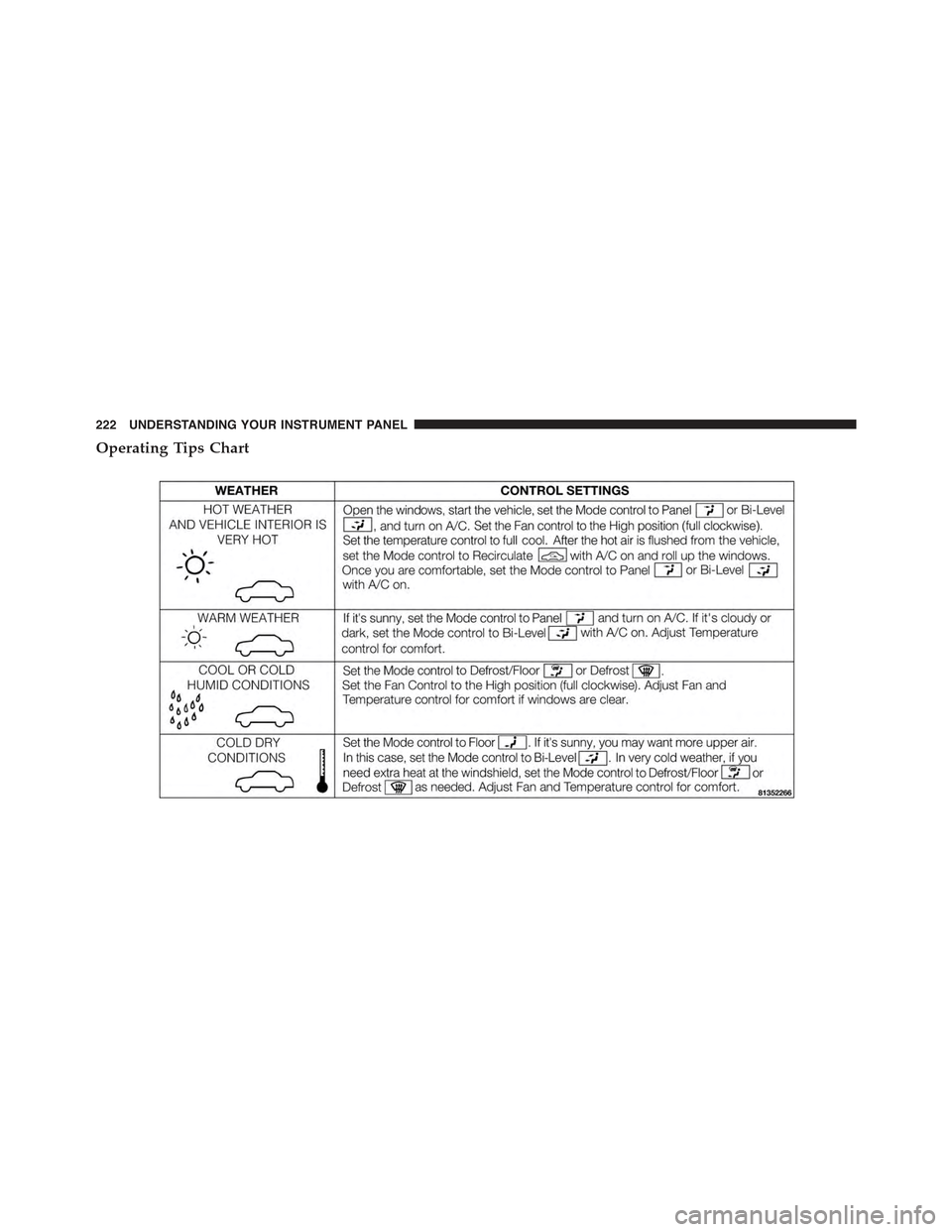
Operating Tips Chart
222 UNDERSTANDING YOUR INSTRUMENT PANEL
Page 225 of 426
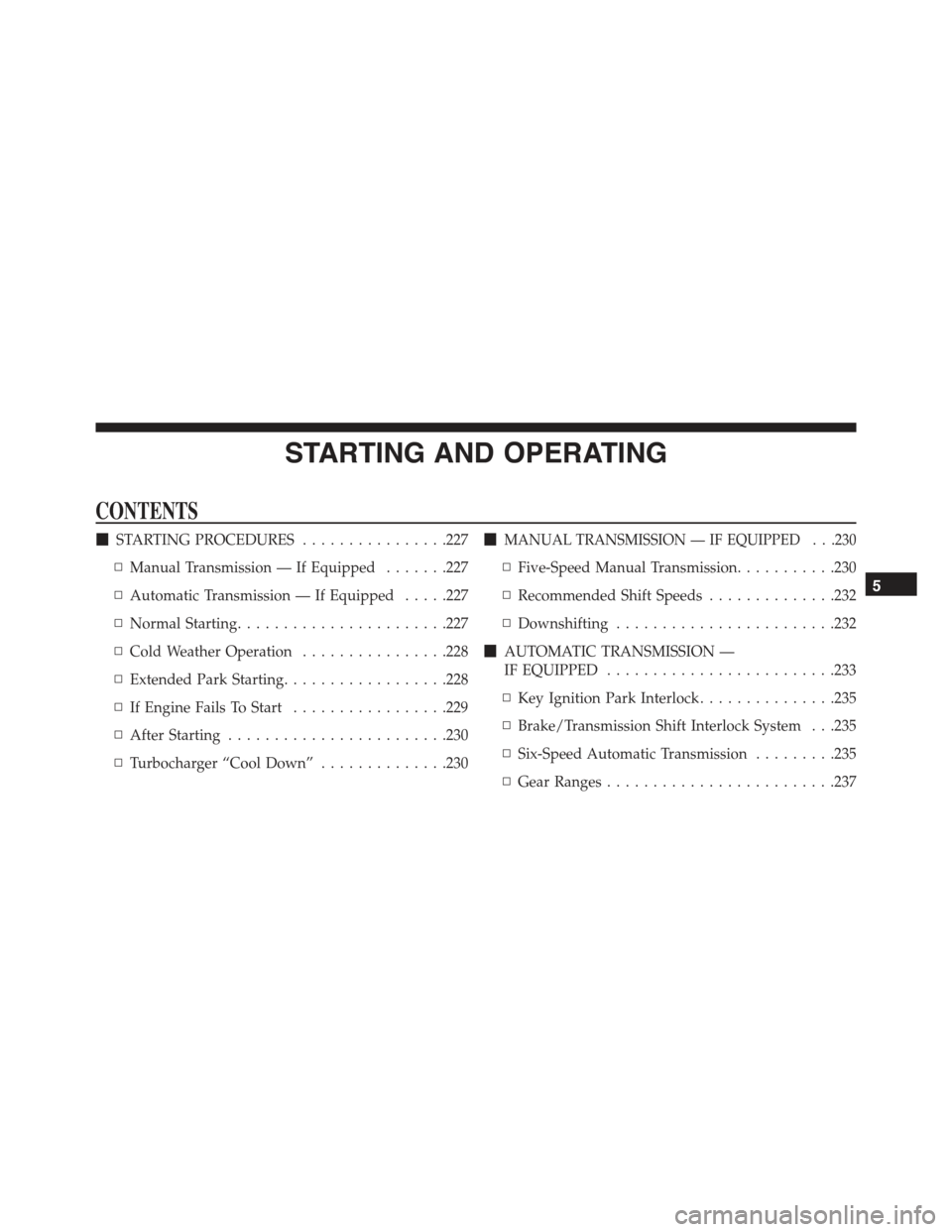
STARTING AND OPERATING
CONTENTS
!STARTING PROCEDURES................227
▫Manual Transmission — If Equipped.......227
▫Automatic Transmission — If Equipped.....227
▫Normal Starting.......................227
▫Cold Weather Operation................228
▫Extended Park Starting..................228
▫If Engine Fails To Start.................229
▫After Starting........................230
▫Turbocharger “Cool Down”..............230
!MANUAL TRANSMISSION — IF EQUIPPED . . .230
▫Five-Speed Manual Transmission...........230
▫Recommended Shift Speeds..............232
▫Downshifting........................232
!AUTOMATIC TRANSMISSION —
IF EQUIPPED.........................233
▫Key Ignition Park Interlock...............235
▫Brake/Transmission Shift Interlock System . . .235
▫Six-Speed Automatic Transmission.........235
▫Gear Ranges.........................237
5
Page 226 of 426
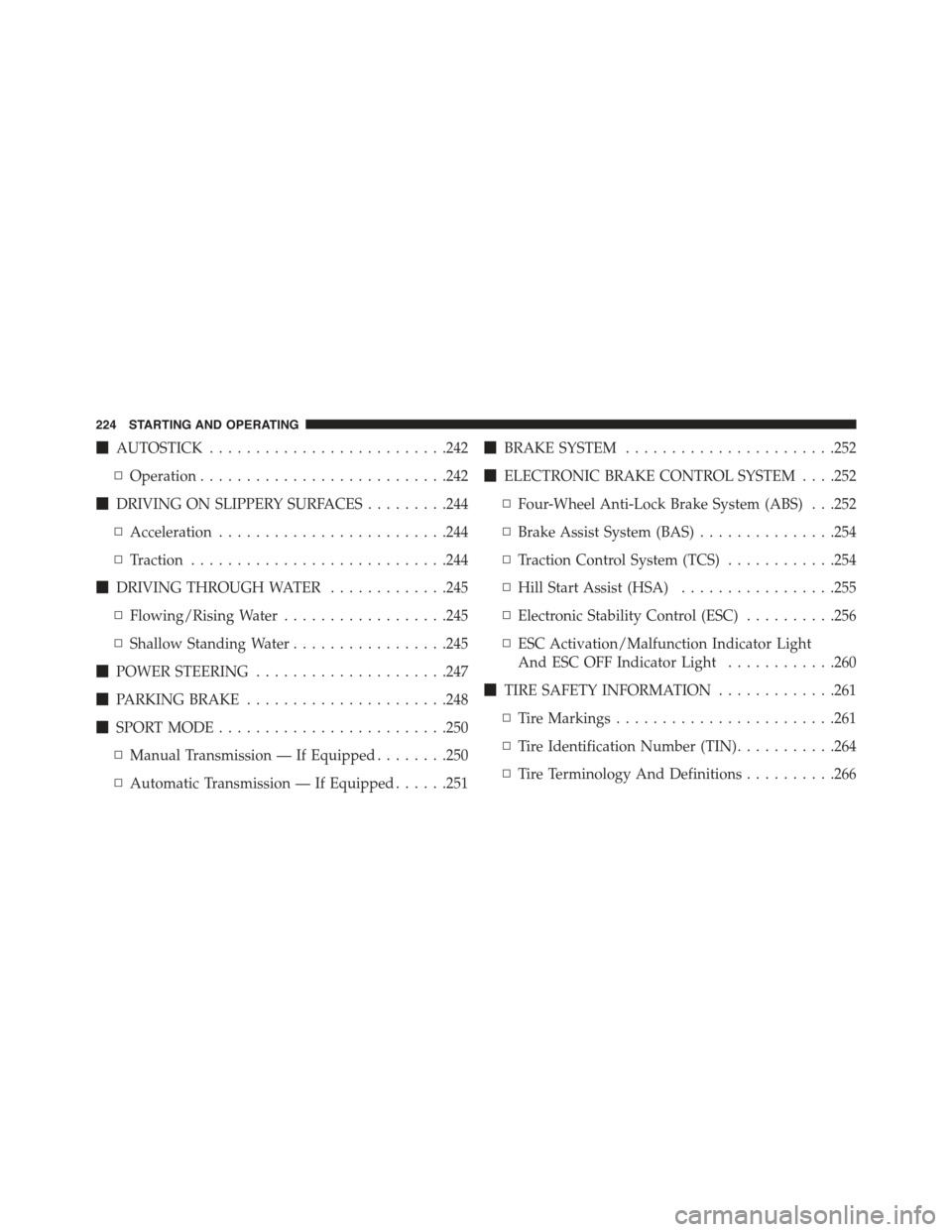
!AUTOSTICK..........................242
▫Operation...........................242
!DRIVING ON SLIPPERY SURFACES.........244
▫Acceleration.........................244
▫Traction............................244
!DRIVING THROUGH WATER.............245
▫Flowing/Rising Water..................245
▫Shallow Standing Water.................245
!POWER STEERING.....................247
!PARKING BRAKE......................248
!SPORT MODE.........................250
▫Manual Transmission — If Equipped........250
▫Automatic Transmission — If Equipped......251
!BRAKE SYSTEM.......................252
!ELECTRONIC BRAKE CONTROL SYSTEM . . . .252
▫Four-Wheel Anti-Lock Brake System (ABS) . . .252
▫Brake Assist System (BAS)...............254
▫Traction Control System (TCS)............254
▫Hill Start Assist (HSA).................255
▫Electronic Stability Control (ESC)..........256
▫ESC Activation/Malfunction Indicator Light
And ESC OFF Indicator Light............260
!TIRE SAFETY INFORMATION.............261
▫Tire Markings........................261
▫Tire Identification Number (TIN)...........264
▫Tire Terminology And Definitions..........266
224 STARTING AND OPERATING
Page 227 of 426
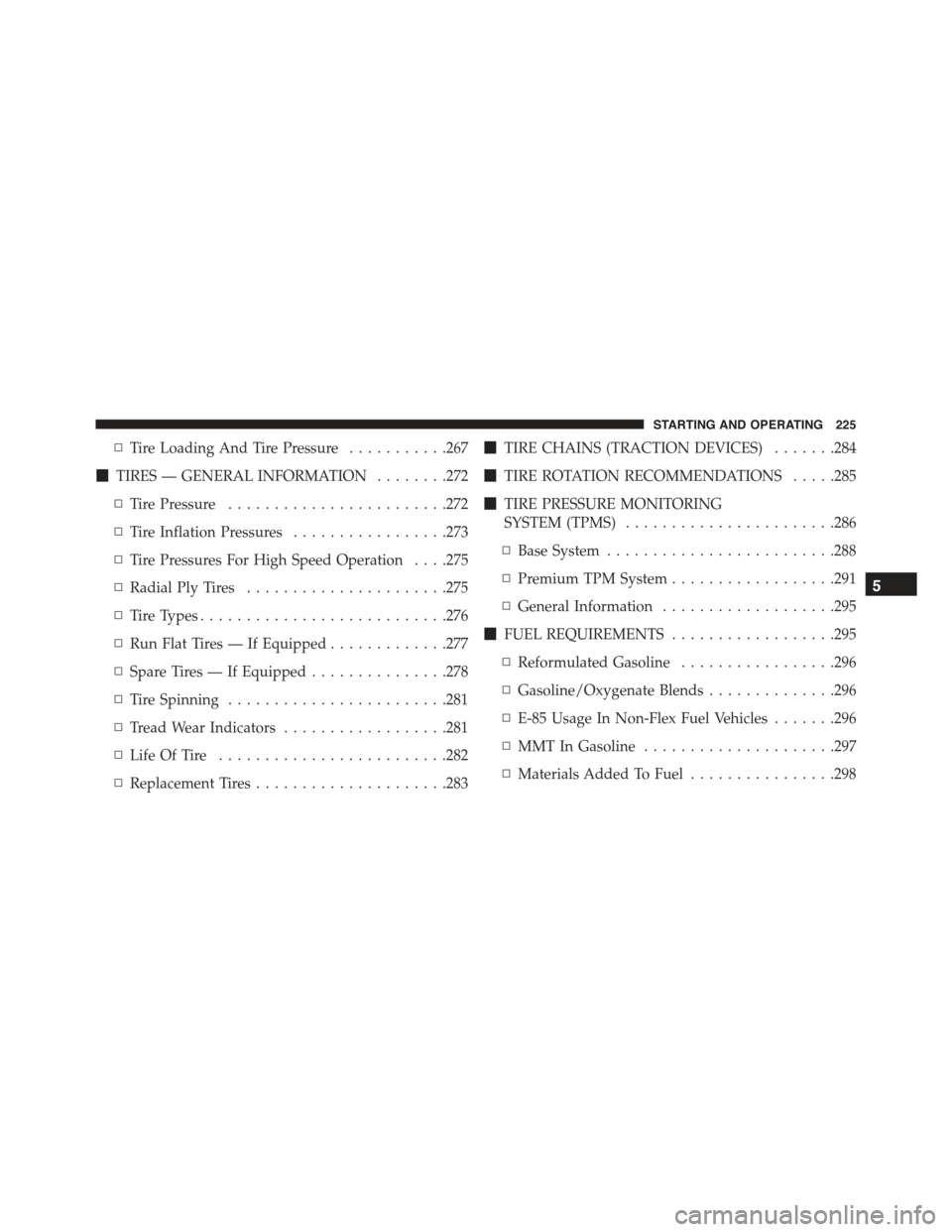
▫Tire Loading And Tire Pressure...........267
!TIRES — GENERAL INFORMATION........272
▫Tire Pressure........................272
▫Tire Inflation Pressures.................273
▫Tire Pressures For High Speed Operation . . . .275
▫Radial Ply Tires......................275
▫Tire Types...........................276
▫Run Flat Tires — If Equipped.............277
▫Spare Tires — If Equipped...............278
▫Tire Spinning........................281
▫Tread Wear Indicators..................281
▫Life Of Tire.........................282
▫Replacement Tires.....................283
!TIRE CHAINS (TRACTION DEVICES).......284
!TIRE ROTATION RECOMMENDATIONS.....285
!TIRE PRESSURE MONITORING
SYSTEM (TPMS).......................286
▫Base System.........................288
▫Premium TPM System..................291
▫General Information...................295
!FUEL REQUIREMENTS..................295
▫Reformulated Gasoline.................296
▫Gasoline/Oxygenate Blends..............296
▫E-85 Usage In Non-Flex Fuel Vehicles.......296
▫MMT In Gasoline.....................297
▫Materials Added To Fuel................298
5
STARTING AND OPERATING 225
Page 228 of 426
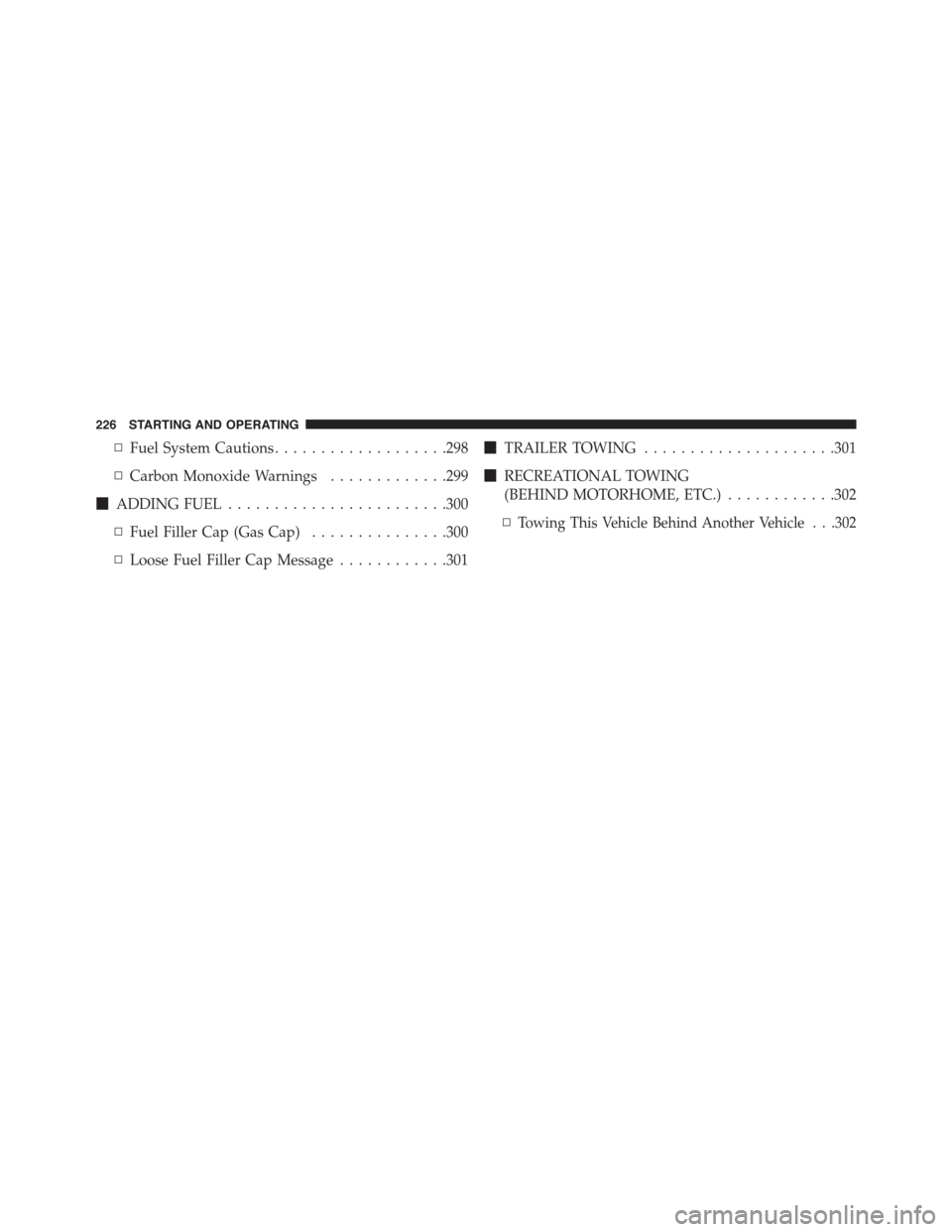
▫Fuel System Cautions...................298
▫Carbon Monoxide Warnings.............299
!ADDING FUEL........................300
▫Fuel Filler Cap (Gas Cap)...............300
▫Loose Fuel Filler Cap Message............301
!TRAILER TOWING.....................301
!RECREATIONAL TOWING
(BEHIND MOTORHOME, ETC.)............302
▫Towing This Vehicle Behind Another Vehicle . . .302
226 STARTING AND OPERATING
Page 229 of 426
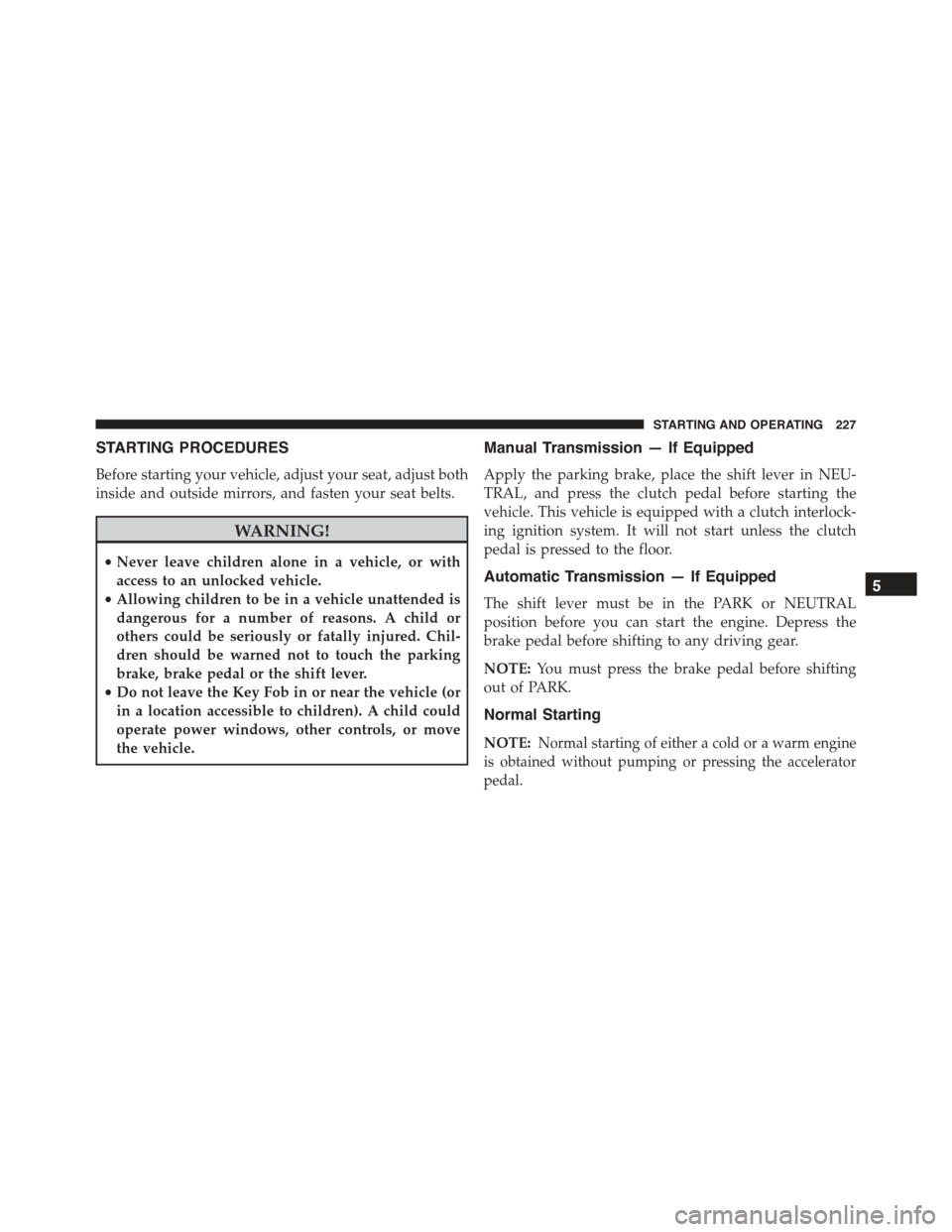
STARTING PROCEDURES
Before starting your vehicle, adjust your seat, adjust both
inside and outside mirrors, and fasten your seat belts.
WARNING!
•Never leave children alone in a vehicle, or with
access to an unlocked vehicle.
•Allowing children to be in a vehicle unattended is
dangerous for a number of reasons. A child or
others could be seriously or fatally injured. Chil-
dren should be warned not to touch the parking
brake, brake pedal or the shift lever.
•Do not leave the Key Fob in or near the vehicle (or
in a location accessible to children). A child could
operate power windows, other controls, or move
the vehicle.
Manual Transmission — If Equipped
Apply the parking brake, place the shift lever in NEU-
TRAL, and press the clutch pedal before starting the
vehicle. This vehicle is equipped with a clutch interlock-
ing ignition system. It will not start unless the clutch
pedal is pressed to the floor.
Automatic Transmission — If Equipped
The shift lever must be in the PARK or NEUTRAL
position before you can start the engine. Depress the
brake pedal before shifting to any driving gear.
NOTE:You must press the brake pedal before shifting
out of PARK.
Normal Starting
NOTE:Normal starting of either a cold or a warm engine
is obtained without pumping or pressing the accelerator
pedal.
5
STARTING AND OPERATING 227
Page 230 of 426
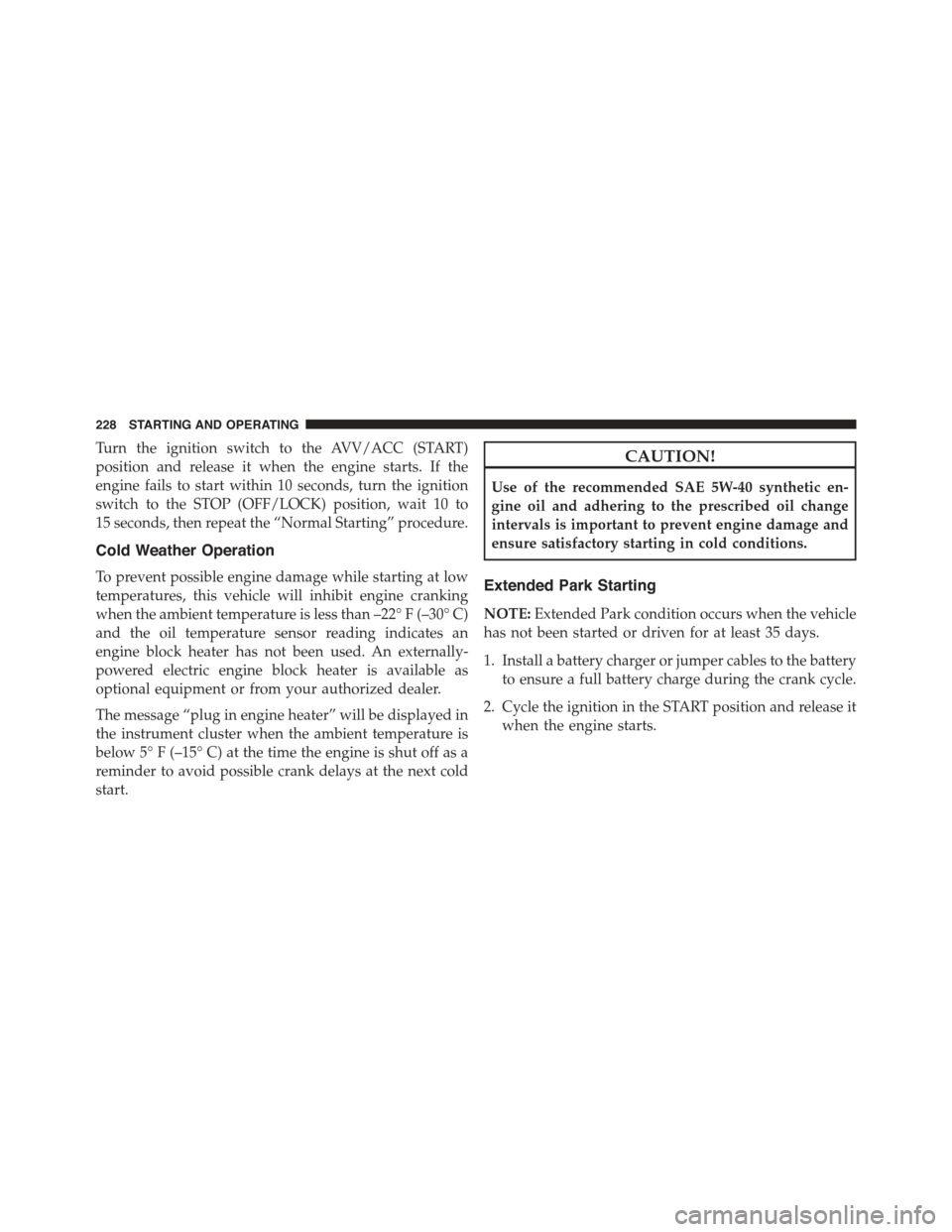
Turn the ignition switch to the AVV/ACC (START)
position and release it when the engine starts. If the
engine fails to start within 10 seconds, turn the ignition
switch to the STOP (OFF/LOCK) position, wait 10 to
15 seconds, then repeat the “Normal Starting” procedure.
Cold Weather Operation
To prevent possible engine damage while starting at low
temperatures, this vehicle will inhibit engine cranking
when the ambient temperature is less than –22° F (–30° C)
and the oil temperature sensor reading indicates an
engine block heater has not been used. An externally-
powered electric engine block heater is available as
optional equipment or from your authorized dealer.
The message “plug in engine heater” will be displayed in
the instrument cluster when the ambient temperature is
below 5° F (–15° C) at the time the engine is shut off as a
reminder to avoid possible crank delays at the next cold
start.
CAUTION!
Use of the recommended SAE 5W-40 synthetic en-
gine oil and adhering to the prescribed oil change
intervals is important to prevent engine damage and
ensure satisfactory starting in cold conditions.
Extended Park Starting
NOTE:Extended Park condition occurs when the vehicle
has not been started or driven for at least 35 days.
1. Install a battery charger or jumper cables to the battery
to ensure a full battery charge during the crank cycle.
2. Cycle the ignition in the START position and release it
when the engine starts.
228 STARTING AND OPERATING